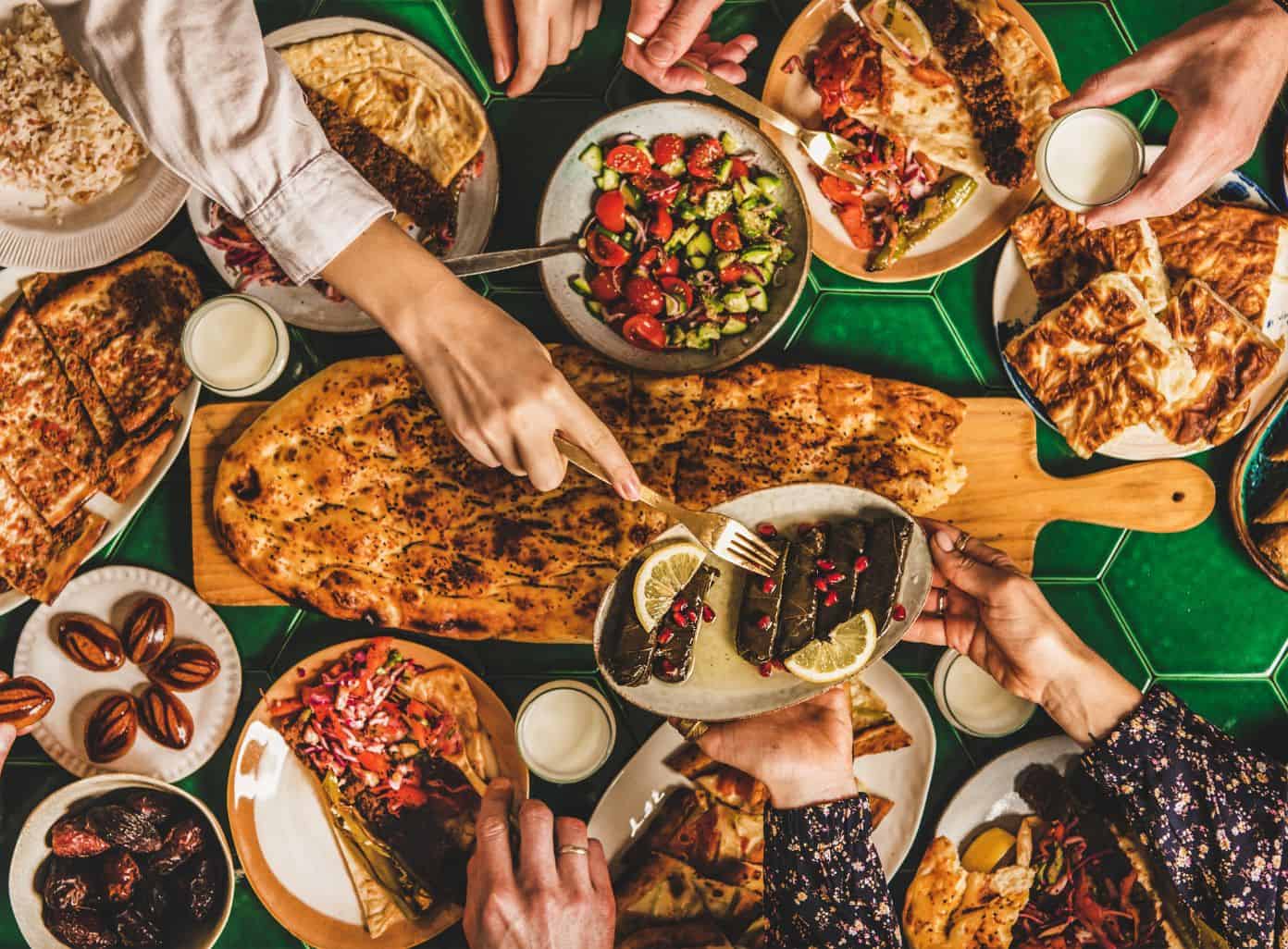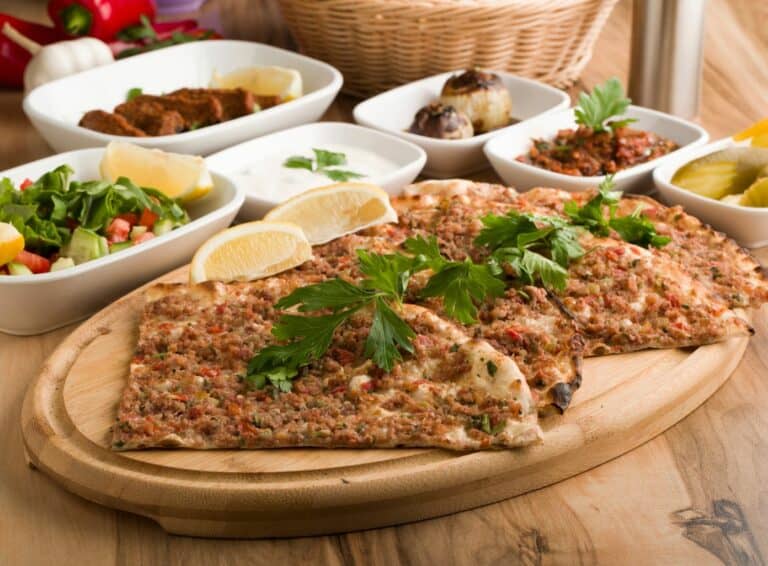Introduction to Turkish Cuisine
Turkey is renowned for its rich culinary heritage that spans centuries. Turkish cuisine is a vibrant tapestry of flavors, colors, and aromas, reflecting the country’s fascinating history and diverse cultural influences. Food holds a special place in Turkish culture, playing an integral role in social gatherings, celebrations, and everyday life.

The Rich Culinary Heritage of Turkey
Turkish cuisine is a captivating blend of ancient traditions and contemporary influences. It draws inspiration from various civilizations that have left their mark on the region over time, including the Ottomans, Persians, and Mediterranean cultures. This fusion of culinary traditions has created a diverse and mouthwatering array of dishes that showcase the country’s unique flavors and cooking techniques.
From hearty stews to delicate pastries, Turkish cuisine offers a wide range of options that cater to different palates and dietary preferences. The use of fresh, seasonal ingredients is a cornerstone of Turkish cooking, ensuring that dishes burst with natural flavors and nutritional value. Herbs, spices, and aromatic oils are often employed to enhance the taste and create unforgettable culinary experiences.
Food as an Integral Part of Turkish Culture
In Turkey, food is more than just sustenance; it is a celebration of togetherness and an expression of love. Sharing meals with family and friends is a cherished tradition that brings people closer and strengthens bonds. Turkish hospitality is legendary, and guests are always treated to an abundance of delicious food and warm hospitality.
Every region in Turkey boasts its own specialties, showcasing the diverse culinary landscape of the country. From the aromatic kebabs of Istanbul to the seafood delights of the Mediterranean coast, each area offers a unique culinary experience that reflects its local culture and ingredients. Exploring the regional variations in Turkish cuisine is a delightful journey that reveals the country’s gastronomic treasures.
To delve deeper into the culinary wonders of Turkey, we will explore traditional Turkish street food, home cooking, the rise of Turkish fine dining, and the must-try dishes and desserts that are sure to tantalize your taste buds. Join us as we uncover the fascinating evolution of Turkish food culture and discover the delicious flavors that await you in this vibrant country.
Continue reading: Traditional Turkish Street Food.

Traditional Turkish Street Food
When exploring the vibrant culinary scene of Turkey, one cannot miss out on the traditional Turkish street food. These delicious and affordable bites offer a glimpse into the rich tapestry of flavors and ingredients that make up Turkish cuisine.
Iconic Street Food Dishes
Turkish street food is known for its diverse range of flavors and textures, influenced by a blend of Middle Eastern, Mediterranean, and Central Asian cuisines. Here are some iconic street food dishes that are worth trying:
- Doner Kebab: Arguably the most famous Turkish street food, doner kebab is a mouthwatering combination of succulent meat (usually lamb or chicken) cooked on a vertical rotisserie. Served in a warm pita bread with fresh vegetables and a drizzle of tangy yogurt sauce, it is a flavorful and filling option.
- Simit: Often referred to as the “Turkish bagel,” simit is a circular bread encrusted with sesame seeds. It is a popular on-the-go snack, enjoyed at breakfast or throughout the day. Simit can be enjoyed plain or filled with various ingredients such as cheese, olives, or sucuk (spicy Turkish sausage).
- Balik Ekmek: A favorite among seafood lovers, balik ekmek is a simple yet satisfying street food dish. It consists of a grilled or fried fish fillet, typically mackerel or sea bass, served in a crusty bread roll with fresh salad and a squeeze of lemon juice. This delightful combination is perfect for enjoying by the seaside.
- Lahmacun: Lahmacun, also known as “Turkish pizza,” is a thin and crispy flatbread topped with a flavorful mixture of minced lamb or beef, onions, tomatoes, and herbs. It is often rolled up with a squeeze of lemon juice and enjoyed as a quick and tasty meal.
Vibrant Flavors and Ingredients
What sets Turkish street food apart is the vibrant array of flavors and ingredients used in their preparation. From the aromatic spices to the fresh herbs and vegetables, each bite is a burst of authentic Turkish taste. Some common ingredients include:
- Sumac: A tangy and citrusy spice used to add a zesty flavor to dishes.
- Pomegranate Molasses: A sweet and sour syrup made from reduced pomegranate juice, often used as a glaze or dressing.
- Mint and Parsley: Fresh herbs that add a refreshing element to many dishes.
- Turkish Chilies: Mild or spicy chilies that add a kick of heat and depth of flavor to various dishes.
- Yogurt: A staple ingredient in Turkish cuisine, yogurt is often used as a cooling accompaniment to balance out the spices.
By indulging in traditional Turkish street food, you can experience the dynamic and vibrant flavors that have become an integral part of Turkish food culture. These culinary delights are not only a treat for your taste buds but also provide a glimpse into the local culture and culinary heritage of Turkey. So, be sure to explore the street food stalls and markets during your visit to Turkey to fully immerse yourself in its gastronomic delights.
Turkish Home Cooking
Homestyle Turkish Dishes
Family Recipes and Regional Specialties
Turkish home cooking is a treasure trove of delicious and comforting dishes that reflect the rich culinary heritage of Turkey. Passed down through generations, family recipes play a significant role in preserving the flavors and traditions of Turkish cuisine. In this section, we will explore the enticing world of homestyle Turkish dishes and the regional specialties that make them unique.
Homestyle Turkish Dishes
Homestyle Turkish dishes are known for their simplicity, fresh ingredients, and robust flavors. These dishes are often made with love and care, showcasing the essence of Turkish hospitality. Here are some popular homestyle Turkish dishes that you must try:
- Manti: Manti is a traditional Turkish dumpling dish that consists of small pockets of dough filled with ground meat, often lamb or beef, and served with yogurt and a drizzle of melted butter.
- Lahmacun: Lahmacun, also known as Turkish pizza, is a thin and crispy flatbread topped with a flavorful mixture of ground meat, onions, tomatoes, and spices. It is commonly enjoyed as a street food snack.
- Pide: Pide is a boat-shaped Turkish bread topped with various ingredients such as cheese, ground meat, spinach, or eggs. It is a popular choice for a quick and satisfying meal.
- Karniyarik: Karniyarik is a classic Turkish stuffed eggplant dish that features eggplants filled with a mixture of ground meat, onions, tomatoes, and herbs. It is traditionally served with rice and a side of yogurt.
Family Recipes and Regional Specialties
Turkish cuisine is incredibly diverse, with each region boasting its own unique specialties and flavors. Family recipes passed down from generation to generation often highlight the distinct culinary traditions of different regions. Here are a few examples of regional specialties in Turkish home cooking:
- Antakya Künefe: Hailing from the Hatay region in southeastern Turkey, Antakya Künefe is a delectable dessert made with shredded filo pastry, melted cheese, sweet syrup, and crushed pistachios. It is a favorite among locals and visitors alike.
- Black Sea Pide: The Black Sea region is known for its lush green landscapes and hearty cuisine. Black Sea Pide is a regional variation of the classic Turkish pide, typically topped with a generous amount of butter, local cheeses, and a variety of herbs.
- Gaziantep Baklava: Gaziantep in southeastern Turkey is famous for its exceptional baklava. Made with layers of thin pastry, finely ground pistachios, and sweet syrup, Gaziantep baklava is renowned for its rich taste and delicate texture.
Exploring Turkish home cooking provides a delightful journey into the heart of Turkish culture and culinary traditions. Whether you savor the comforting flavors of homestyle dishes or indulge in the regional specialties, Turkish cuisine offers a vast array of culinary delights that are sure to please your taste buds. To learn more about Turkish cuisine and its fascinating history, check out our article on turkey cuisine.
The Rise of Turkish Fine Dining
As the culinary scene in Turkey continues to evolve, there has been a remarkable rise in Turkish fine dining establishments that showcase a fusion of traditional and modern techniques. These restaurants have gained recognition not only within Turkey but also internationally, with some even earning prestigious Michelin stars.
Fusion of Traditional and Modern Techniques
Turkish fine dining restaurants are known for their innovative approach to traditional Turkish cuisine. They skillfully blend age-old cooking techniques with modern culinary methods to create unique and exciting flavor profiles. Chefs draw inspiration from the rich culinary heritage of Turkey, using traditional ingredients and recipes as a foundation for their creations.
These restaurants often experiment with different cooking styles, such as sous vide, molecular gastronomy, and deconstruction, while still honoring the essence of Turkish cuisine. The result is a harmonious marriage of flavors and textures that push the boundaries of traditional Turkish dishes.
Michelin-Starred Turkish Restaurants
The growth of Turkish fine dining can be seen in the recognition received by several restaurants in Turkey. The prestigious Michelin Guide has awarded stars to a handful of Turkish establishments, solidifying their place on the global culinary map.
These Michelin-starred Turkish restaurants offer an exceptional dining experience, showcasing the creativity and expertise of their chefs. From Istanbul to other culinary destinations in Turkey, these restaurants attract both locals and international food enthusiasts, eager to indulge in the refined flavors and impeccable presentation.
While the specific restaurants awarded Michelin stars may vary from year to year, their recognition speaks to the growing reputation of Turkish cuisine on the international stage. These accolades highlight the dedication and skill of Turkish chefs in elevating traditional dishes to new heights.
Discovering the world of Turkish fine dining allows you to experience the exciting evolution of Turkish cuisine. Whether you’re a visitor or a local, these restaurants provide a unique opportunity to savor the flavors of Turkey in a refined setting. Embark on a gastronomic journey that embraces the traditions of Turkish cuisine while embracing the creativity and innovation of modern culinary techniques.
As you explore the diverse culinary landscape of Turkey, don’t forget to also indulge in the regional variations and influences of Ottoman, Persian, and Mediterranean cultures. To learn more about the regional variations in Turkish cuisine, refer to our article on Turkish food culture.
Exploring Turkish Food Culture
Turkey’s culinary landscape is incredibly diverse, with each region boasting its own unique flavors and specialties. The regional variations in Turkish cuisine are a testament to the country’s rich cultural heritage and geographical diversity. From the bustling streets of Istanbul to the tranquil villages of Anatolia, Turkish food culture is a vibrant tapestry of flavors and influences.
Regional Variations in Turkish Cuisine
One of the fascinating aspects of Turkish cuisine is the regional variations found throughout the country. Each region offers its own distinct culinary traditions and dishes, shaped by the local ingredients and cultural influences. For example:
- Mediterranean Region: Located along the southern coast, this region is known for its abundant use of olive oil, fresh herbs, and seafood. The cuisine here is characterized by refreshing salads, grilled meats, and flavorsome mezes (appetizers).
- Aegean Region: With its fertile lands and proximity to the sea, the Aegean region boasts a rich culinary heritage. Olive oil, vegetables, herbs, and dairy products play a prominent role in dishes such as stuffed vegetables, herb-infused olive oil dishes, and delectable seafood.
- Central Anatolia: In the heart of Turkey, Central Anatolia showcases a diverse range of dishes. Wheat-based foods like bread and bulgur are staples, along with hearty stews, kebabs, and unique specialties like manti (Turkish dumplings).
- Eastern Anatolia: This mountainous region is known for its robust and flavorful dishes. Lamb and beef take center stage, with specialties such as kebabs, koftas, and hearty soups. The cuisine also features a wide array of dairy products and spices.
By exploring the regional variations in Turkish cuisine, visitors can embark on a culinary journey that spans the breadth of the country, experiencing the unique flavors and traditions that each region has to offer.
Culinary Influences from Ottoman, Persian, and Mediterranean Cultures
Turkish cuisine is a melting pot of cultural influences, with a rich history that spans centuries. The Ottoman Empire played a significant role in shaping Turkish cuisine, leaving behind a legacy of intricate flavors and techniques. The Ottoman court cuisine, known as “Ottoman Palace Cuisine,” was renowned for its lavish feasts and elaborate dishes. Many traditional Turkish recipes and cooking methods trace their origins back to this period.
In addition to Ottoman influences, Turkish cuisine has been influenced by Persian and Mediterranean cultures. Persian culinary traditions, such as the use of saffron, dried fruits, and aromatic spices, have found their way into Turkish cuisine, adding depth and complexity to many dishes.
The Mediterranean influence is particularly strong in the southern regions of Turkey, where the cuisine showcases a harmonious blend of flavors from Greece, Italy, and the Middle East. Olive oil, fresh vegetables, and seafood are key components of Mediterranean-inspired Turkish dishes.
By embracing these diverse influences, Turkish cuisine has evolved into a tapestry of flavors that captivates the taste buds and reflects the country’s rich cultural heritage.
As you explore the culinary wonders of Turkey, be sure to savor the regional variations and appreciate the cultural influences that have shaped this vibrant and diverse food culture. From the Mediterranean coast to the eastern mountains, Turkish cuisine offers a delightful gastronomic adventure that will leave you craving for more.
Must-Try Turkish Dishes and Desserts
No exploration of Turkish cuisine would be complete without indulging in some of the must-try Turkish dishes and desserts. From savory main courses to mouthwatering sweets, Turkish cuisine offers a delightful array of flavors and textures.
Popular Turkish Main Courses and Mezes
Turkish cuisine is renowned for its rich and diverse range of main courses and mezes (appetizers). These dishes showcase the vibrant flavors and creative use of ingredients that make Turkish cuisine so unique.
| Dish | Description |
|---|---|
| Kebabs | A variety of kebabs, such as shish kebab (skewered meat), doner kebab (rotating spit-roasted meat), and adana kebab (spicy minced meat), are popular choices for meat lovers. These flavorful and succulent grilled meats are often served with rice, bread, and a side salad. |
| Dolma | Dolma refers to a family of stuffed vegetable dishes. Yaprak dolma (stuffed grape leaves) and biber dolma (stuffed bell peppers) are among the most beloved variations. These delicacies are typically filled with a mixture of rice, herbs, and spices, creating a burst of flavors in every bite. |
| Manti | Manti is a traditional Turkish dumpling dish. These small, bite-sized dumplings are typically filled with seasoned ground meat and served with yogurt and spices. Manti is a true delight for the taste buds, combining savory and tangy flavors. |
| Pide | Pide is often referred to as Turkish pizza. It is a boat-shaped flatbread topped with various ingredients, such as cheese, meat, vegetables, and herbs. Pide is a popular street food and can be enjoyed in many different flavors and combinations. |
| Lahmacun | Lahmacun, also known as Turkish flatbread, is a thin and crispy bread topped with minced meat, vegetables, and herbs. It is commonly rolled up with lettuce, tomatoes, and a squeeze of lemon juice, creating a delicious and portable meal. |
Indulgent Turkish Sweets and Pastries
Turkish cuisine is famous for its delectable sweets and pastries. These indulgent treats are often enjoyed with a cup of Turkish tea or Turkish coffee.
| Dessert | Description |
|---|---|
| Baklava | Baklava is a rich and sweet pastry made of layers of filo dough filled with chopped nuts and sweetened with syrup or honey. This delightful treat is often sprinkled with ground cinnamon and served as a dessert or during special occasions. |
| Turkish Delight | Turkish delight, also known as lokum, is a gel-like confectionary made with starch, sugar, and flavorings such as rosewater or citrus. These bite-sized delights come in a variety of flavors and are often dusted with powdered sugar. |
| Kunefe | Kunefe is a warm and gooey dessert made with shredded phyllo dough, cheese, and sweet syrup. It is typically served with a dollop of clotted cream or a scoop of ice cream, creating a perfect balance of sweet and creamy flavors. |
| Sutlac | Sutlac is a creamy rice pudding made with rice, milk, sugar, and a hint of vanilla. It is often garnished with a sprinkle of cinnamon and served chilled. Sutlac is a comforting and satisfying dessert enjoyed by locals and visitors alike. |
| Revani | Revani is a semolina cake soaked in sweet syrup, often flavored with lemon or orange. This moist and fragrant cake is popular throughout Turkey and is a delightful way to end a meal. |
Exploring the diverse range of Turkish dishes and desserts is a journey of culinary delights. From savory main courses to irresistible sweets, Turkish cuisine offers something to please every palate. Whether you’re a meat lover, a vegetarian, or have a sweet tooth, Turkish cuisine is sure to captivate your taste buds and leave you craving for more.


